AIS Report: Business Intelligence Growth and Ethical Conduct Analysis
VerifiedAdded on 2022/11/28
|9
|1758
|360
Report
AI Summary
This report provides a comprehensive analysis of Accounting Information Systems (AIS), focusing on the growth and impact of business intelligence (BI) and the importance of business ethics. The first part of the report explores the evolution of BI, highlighting its significance in organizational decision-making and showcasing various BI tools like SAP, MicroStrategy, SAS, and Dundas BI. The second part delves into business ethics, using the Enron scandal as a case study to illustrate breaches of ethical conduct, the associated issues, and the measures implemented to mitigate risks. The report emphasizes the critical role of ethical practices in business operations and the consequences of unethical behavior, providing valuable insights into corporate governance and financial reporting.
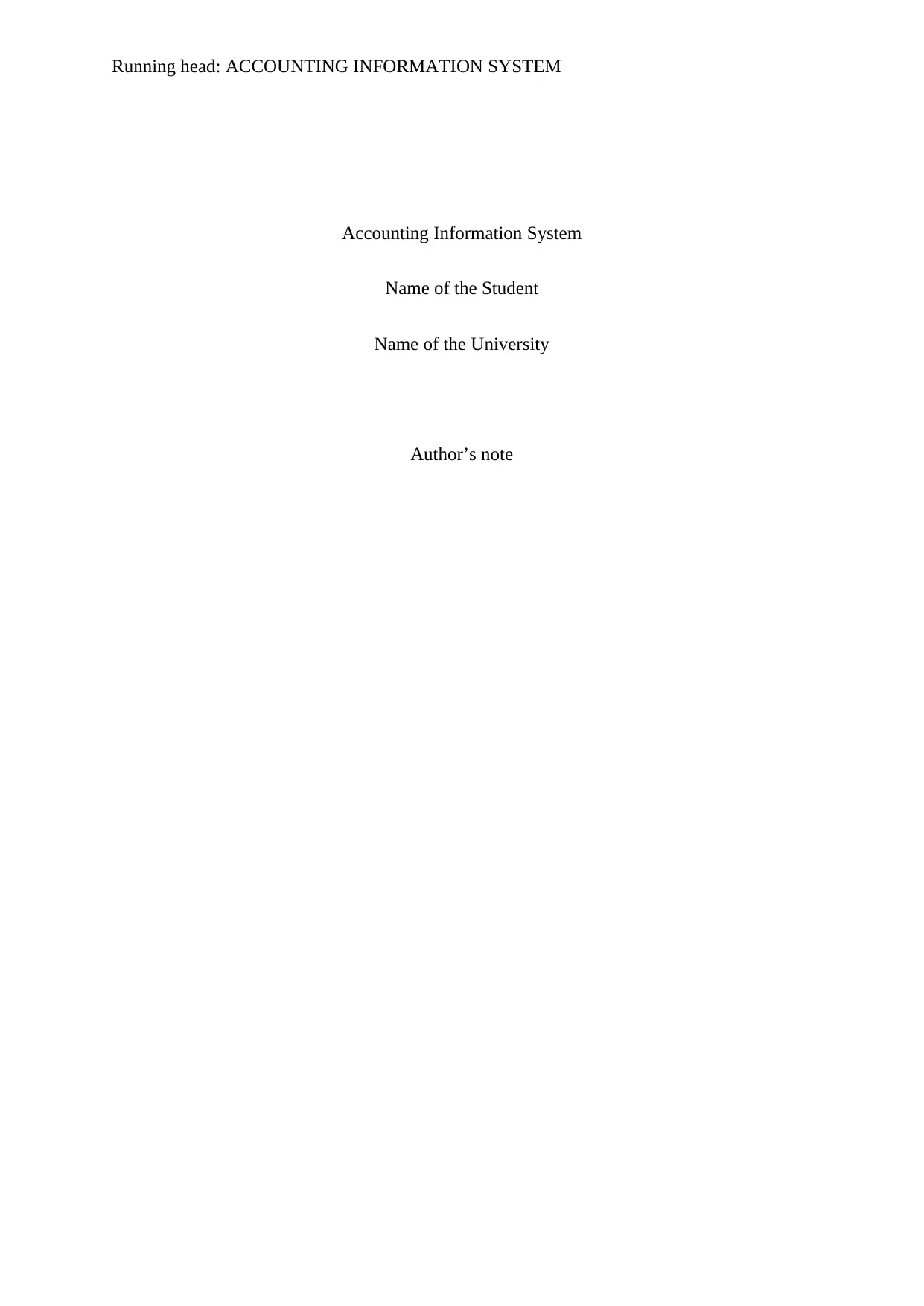
Running head: ACCOUNTING INFORMATION SYSTEM
Accounting Information System
Name of the Student
Name of the University
Author’s note
Accounting Information System
Name of the Student
Name of the University
Author’s note
Paraphrase This Document
Need a fresh take? Get an instant paraphrase of this document with our AI Paraphraser
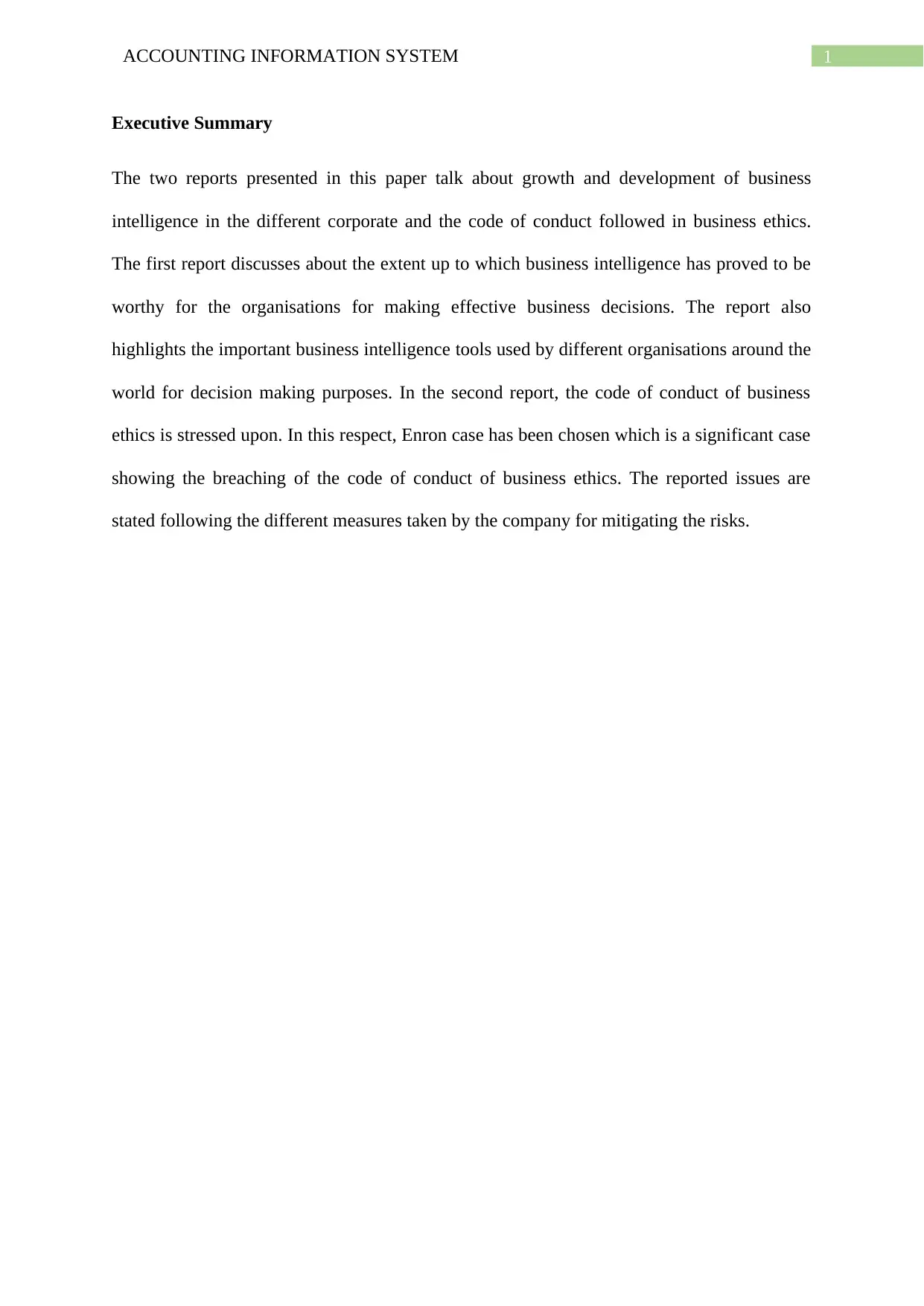
1ACCOUNTING INFORMATION SYSTEM
Executive Summary
The two reports presented in this paper talk about growth and development of business
intelligence in the different corporate and the code of conduct followed in business ethics.
The first report discusses about the extent up to which business intelligence has proved to be
worthy for the organisations for making effective business decisions. The report also
highlights the important business intelligence tools used by different organisations around the
world for decision making purposes. In the second report, the code of conduct of business
ethics is stressed upon. In this respect, Enron case has been chosen which is a significant case
showing the breaching of the code of conduct of business ethics. The reported issues are
stated following the different measures taken by the company for mitigating the risks.
Executive Summary
The two reports presented in this paper talk about growth and development of business
intelligence in the different corporate and the code of conduct followed in business ethics.
The first report discusses about the extent up to which business intelligence has proved to be
worthy for the organisations for making effective business decisions. The report also
highlights the important business intelligence tools used by different organisations around the
world for decision making purposes. In the second report, the code of conduct of business
ethics is stressed upon. In this respect, Enron case has been chosen which is a significant case
showing the breaching of the code of conduct of business ethics. The reported issues are
stated following the different measures taken by the company for mitigating the risks.
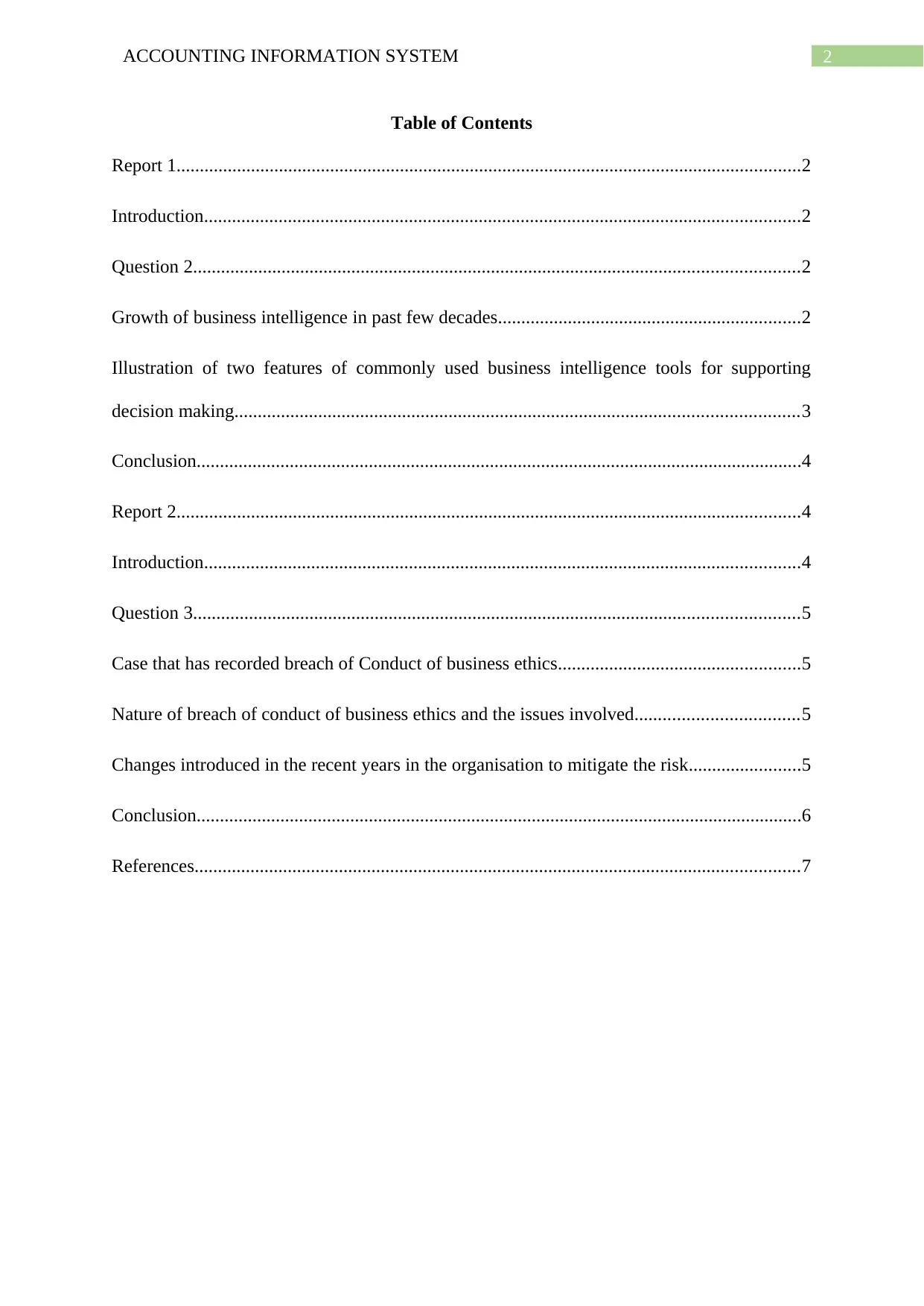
2ACCOUNTING INFORMATION SYSTEM
Table of Contents
Report 1......................................................................................................................................2
Introduction................................................................................................................................2
Question 2..................................................................................................................................2
Growth of business intelligence in past few decades.................................................................2
Illustration of two features of commonly used business intelligence tools for supporting
decision making.........................................................................................................................3
Conclusion..................................................................................................................................4
Report 2......................................................................................................................................4
Introduction................................................................................................................................4
Question 3..................................................................................................................................5
Case that has recorded breach of Conduct of business ethics....................................................5
Nature of breach of conduct of business ethics and the issues involved...................................5
Changes introduced in the recent years in the organisation to mitigate the risk........................5
Conclusion..................................................................................................................................6
References..................................................................................................................................7
Table of Contents
Report 1......................................................................................................................................2
Introduction................................................................................................................................2
Question 2..................................................................................................................................2
Growth of business intelligence in past few decades.................................................................2
Illustration of two features of commonly used business intelligence tools for supporting
decision making.........................................................................................................................3
Conclusion..................................................................................................................................4
Report 2......................................................................................................................................4
Introduction................................................................................................................................4
Question 3..................................................................................................................................5
Case that has recorded breach of Conduct of business ethics....................................................5
Nature of breach of conduct of business ethics and the issues involved...................................5
Changes introduced in the recent years in the organisation to mitigate the risk........................5
Conclusion..................................................................................................................................6
References..................................................................................................................................7
⊘ This is a preview!⊘
Do you want full access?
Subscribe today to unlock all pages.

Trusted by 1+ million students worldwide

3ACCOUNTING INFORMATION SYSTEM
Report 1
Introduction
The primary objective behind this report is to provide a general discussion regarding
the growth of business of intelligence in the last few decades. The report also gives a
highlight about the two different kinds of business tools that are useful for making important
business decisions.
Question 2
Growth of business intelligence in past few decades
The term that is regarded as the business intelligence has evolved prominently in the
course of the past several decades (Rajnoha et al. 2016). The term can be related to the
growth and development of internet. The major development of business intelligence
happened in the early 20th century even with the presence of the physical copies of data
reports.
The above figure shows the growth of business intelligence market in the global
phenomenon from 2016 to 2019 and also in the futuristic world.
Report 1
Introduction
The primary objective behind this report is to provide a general discussion regarding
the growth of business of intelligence in the last few decades. The report also gives a
highlight about the two different kinds of business tools that are useful for making important
business decisions.
Question 2
Growth of business intelligence in past few decades
The term that is regarded as the business intelligence has evolved prominently in the
course of the past several decades (Rajnoha et al. 2016). The term can be related to the
growth and development of internet. The major development of business intelligence
happened in the early 20th century even with the presence of the physical copies of data
reports.
The above figure shows the growth of business intelligence market in the global
phenomenon from 2016 to 2019 and also in the futuristic world.
Paraphrase This Document
Need a fresh take? Get an instant paraphrase of this document with our AI Paraphraser
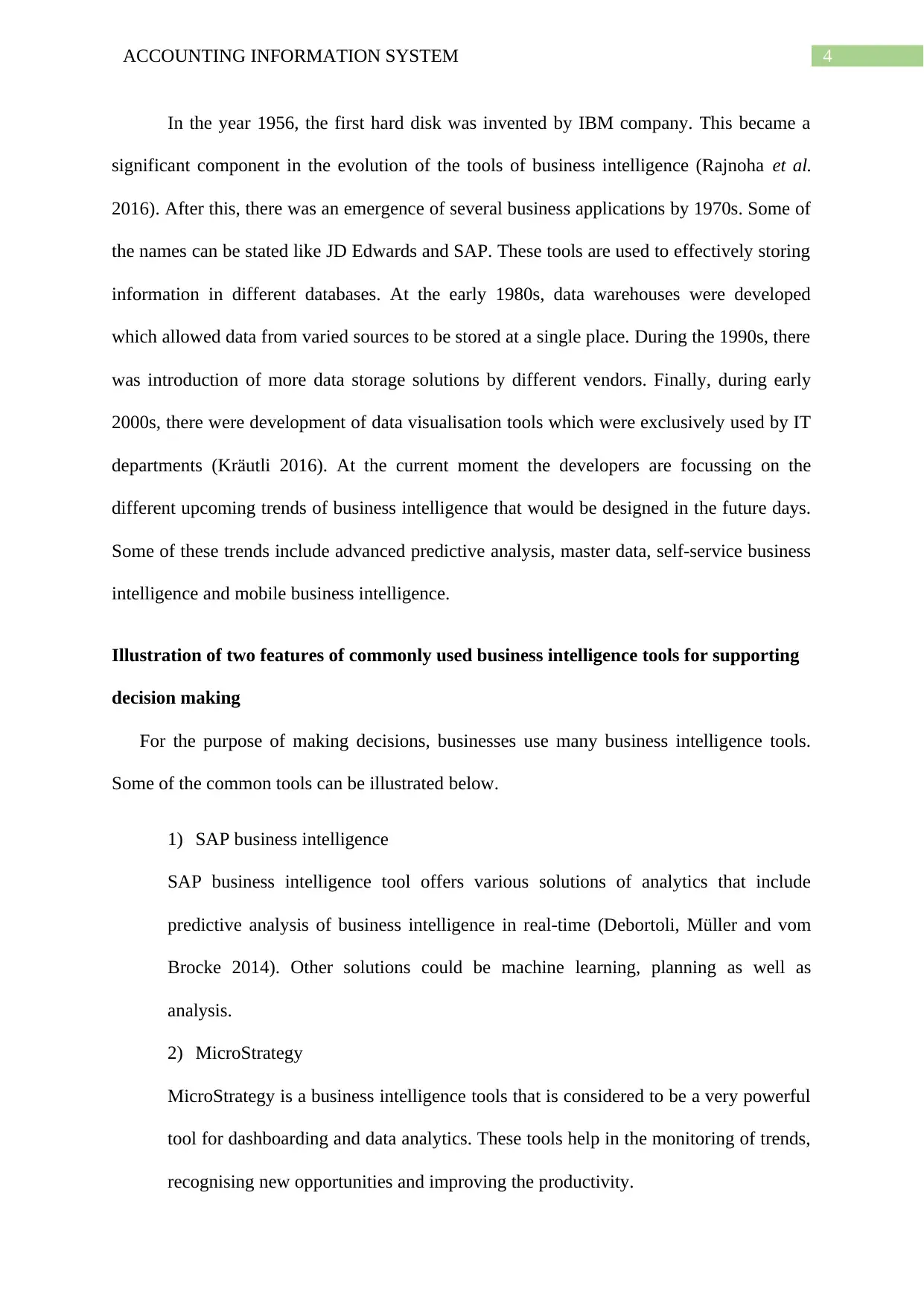
4ACCOUNTING INFORMATION SYSTEM
In the year 1956, the first hard disk was invented by IBM company. This became a
significant component in the evolution of the tools of business intelligence (Rajnoha et al.
2016). After this, there was an emergence of several business applications by 1970s. Some of
the names can be stated like JD Edwards and SAP. These tools are used to effectively storing
information in different databases. At the early 1980s, data warehouses were developed
which allowed data from varied sources to be stored at a single place. During the 1990s, there
was introduction of more data storage solutions by different vendors. Finally, during early
2000s, there were development of data visualisation tools which were exclusively used by IT
departments (Kräutli 2016). At the current moment the developers are focussing on the
different upcoming trends of business intelligence that would be designed in the future days.
Some of these trends include advanced predictive analysis, master data, self-service business
intelligence and mobile business intelligence.
Illustration of two features of commonly used business intelligence tools for supporting
decision making
For the purpose of making decisions, businesses use many business intelligence tools.
Some of the common tools can be illustrated below.
1) SAP business intelligence
SAP business intelligence tool offers various solutions of analytics that include
predictive analysis of business intelligence in real-time (Debortoli, Müller and vom
Brocke 2014). Other solutions could be machine learning, planning as well as
analysis.
2) MicroStrategy
MicroStrategy is a business intelligence tools that is considered to be a very powerful
tool for dashboarding and data analytics. These tools help in the monitoring of trends,
recognising new opportunities and improving the productivity.
In the year 1956, the first hard disk was invented by IBM company. This became a
significant component in the evolution of the tools of business intelligence (Rajnoha et al.
2016). After this, there was an emergence of several business applications by 1970s. Some of
the names can be stated like JD Edwards and SAP. These tools are used to effectively storing
information in different databases. At the early 1980s, data warehouses were developed
which allowed data from varied sources to be stored at a single place. During the 1990s, there
was introduction of more data storage solutions by different vendors. Finally, during early
2000s, there were development of data visualisation tools which were exclusively used by IT
departments (Kräutli 2016). At the current moment the developers are focussing on the
different upcoming trends of business intelligence that would be designed in the future days.
Some of these trends include advanced predictive analysis, master data, self-service business
intelligence and mobile business intelligence.
Illustration of two features of commonly used business intelligence tools for supporting
decision making
For the purpose of making decisions, businesses use many business intelligence tools.
Some of the common tools can be illustrated below.
1) SAP business intelligence
SAP business intelligence tool offers various solutions of analytics that include
predictive analysis of business intelligence in real-time (Debortoli, Müller and vom
Brocke 2014). Other solutions could be machine learning, planning as well as
analysis.
2) MicroStrategy
MicroStrategy is a business intelligence tools that is considered to be a very powerful
tool for dashboarding and data analytics. These tools help in the monitoring of trends,
recognising new opportunities and improving the productivity.
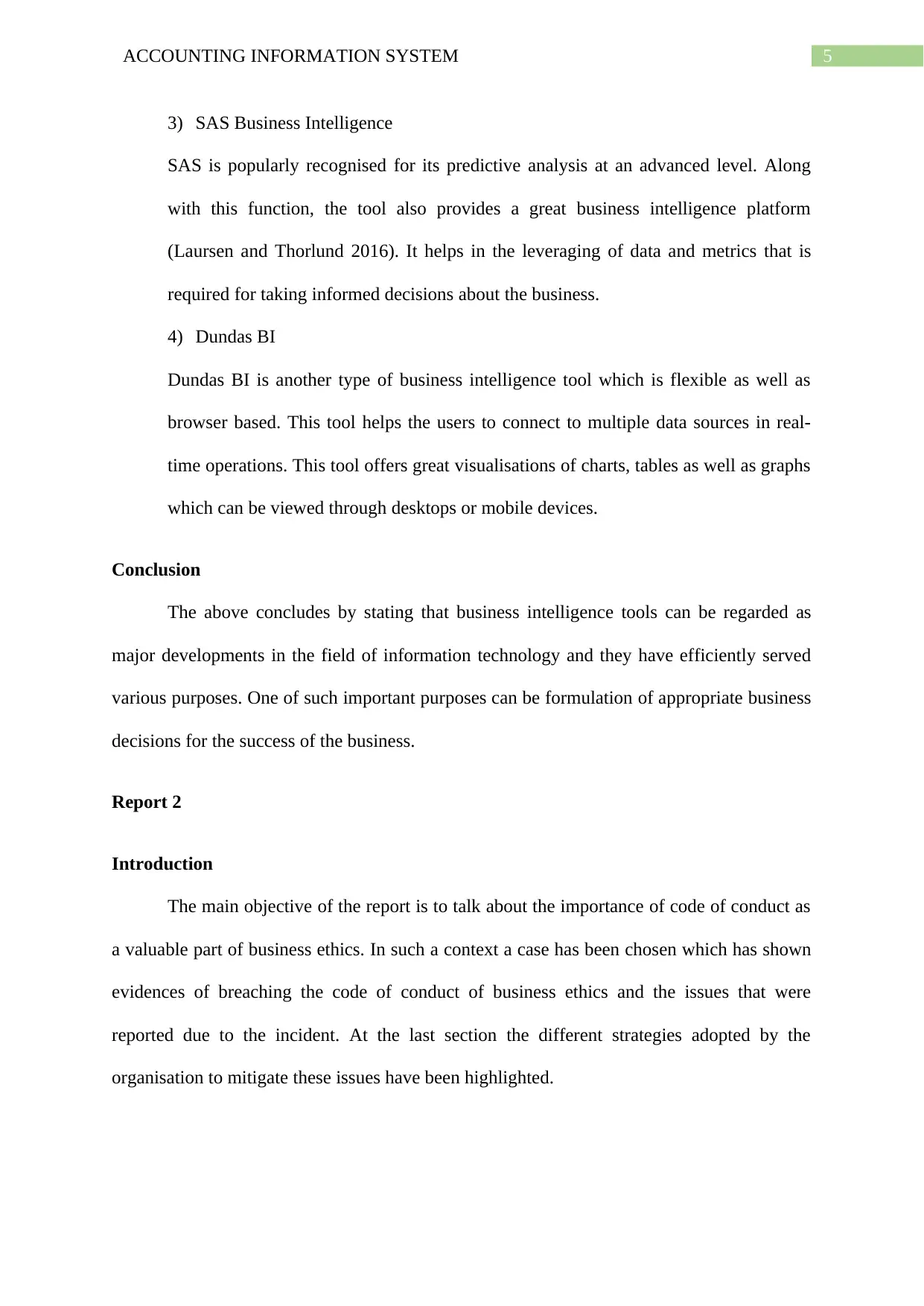
5ACCOUNTING INFORMATION SYSTEM
3) SAS Business Intelligence
SAS is popularly recognised for its predictive analysis at an advanced level. Along
with this function, the tool also provides a great business intelligence platform
(Laursen and Thorlund 2016). It helps in the leveraging of data and metrics that is
required for taking informed decisions about the business.
4) Dundas BI
Dundas BI is another type of business intelligence tool which is flexible as well as
browser based. This tool helps the users to connect to multiple data sources in real-
time operations. This tool offers great visualisations of charts, tables as well as graphs
which can be viewed through desktops or mobile devices.
Conclusion
The above concludes by stating that business intelligence tools can be regarded as
major developments in the field of information technology and they have efficiently served
various purposes. One of such important purposes can be formulation of appropriate business
decisions for the success of the business.
Report 2
Introduction
The main objective of the report is to talk about the importance of code of conduct as
a valuable part of business ethics. In such a context a case has been chosen which has shown
evidences of breaching the code of conduct of business ethics and the issues that were
reported due to the incident. At the last section the different strategies adopted by the
organisation to mitigate these issues have been highlighted.
3) SAS Business Intelligence
SAS is popularly recognised for its predictive analysis at an advanced level. Along
with this function, the tool also provides a great business intelligence platform
(Laursen and Thorlund 2016). It helps in the leveraging of data and metrics that is
required for taking informed decisions about the business.
4) Dundas BI
Dundas BI is another type of business intelligence tool which is flexible as well as
browser based. This tool helps the users to connect to multiple data sources in real-
time operations. This tool offers great visualisations of charts, tables as well as graphs
which can be viewed through desktops or mobile devices.
Conclusion
The above concludes by stating that business intelligence tools can be regarded as
major developments in the field of information technology and they have efficiently served
various purposes. One of such important purposes can be formulation of appropriate business
decisions for the success of the business.
Report 2
Introduction
The main objective of the report is to talk about the importance of code of conduct as
a valuable part of business ethics. In such a context a case has been chosen which has shown
evidences of breaching the code of conduct of business ethics and the issues that were
reported due to the incident. At the last section the different strategies adopted by the
organisation to mitigate these issues have been highlighted.
⊘ This is a preview!⊘
Do you want full access?
Subscribe today to unlock all pages.

Trusted by 1+ million students worldwide
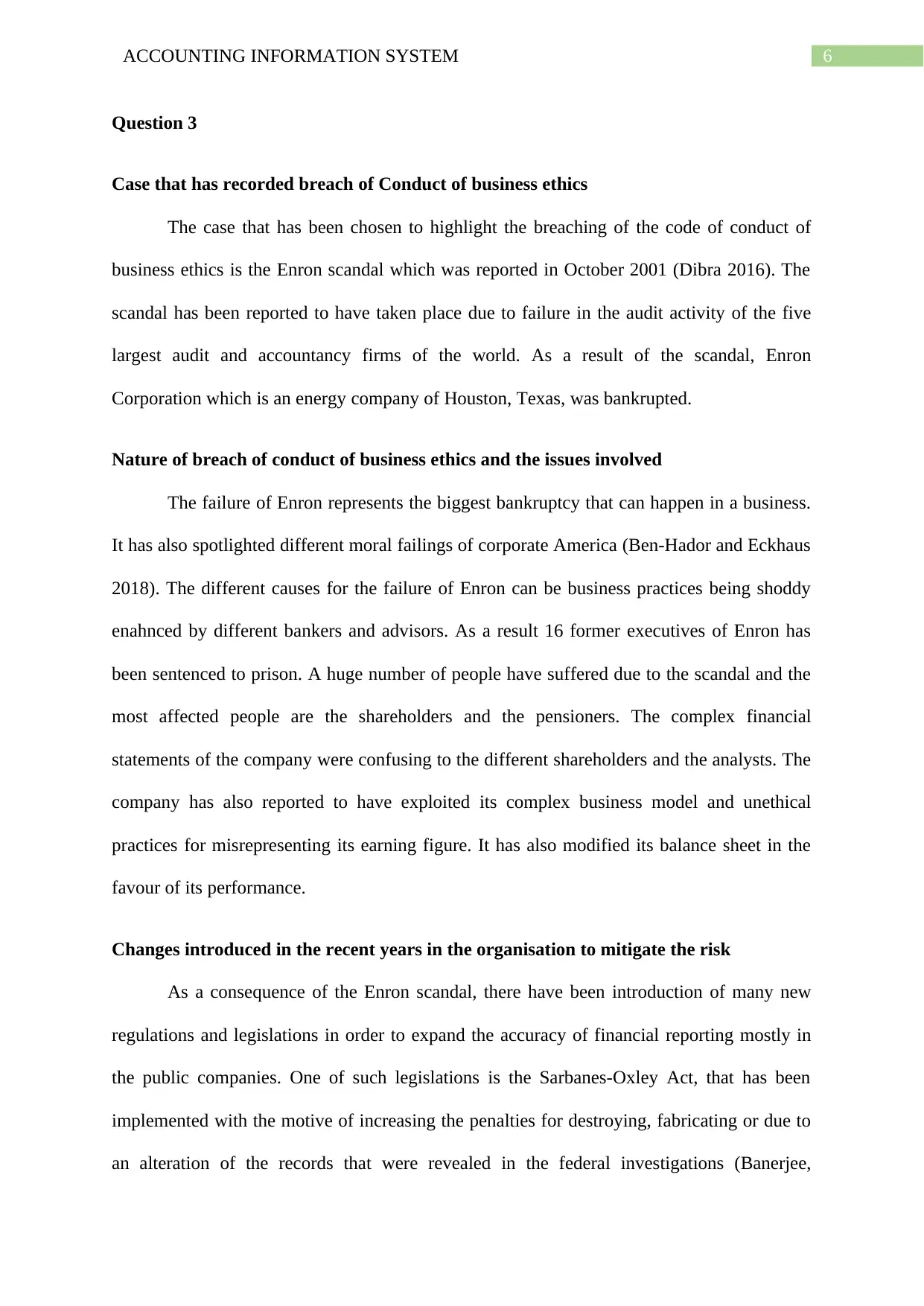
6ACCOUNTING INFORMATION SYSTEM
Question 3
Case that has recorded breach of Conduct of business ethics
The case that has been chosen to highlight the breaching of the code of conduct of
business ethics is the Enron scandal which was reported in October 2001 (Dibra 2016). The
scandal has been reported to have taken place due to failure in the audit activity of the five
largest audit and accountancy firms of the world. As a result of the scandal, Enron
Corporation which is an energy company of Houston, Texas, was bankrupted.
Nature of breach of conduct of business ethics and the issues involved
The failure of Enron represents the biggest bankruptcy that can happen in a business.
It has also spotlighted different moral failings of corporate America (Ben-Hador and Eckhaus
2018). The different causes for the failure of Enron can be business practices being shoddy
enahnced by different bankers and advisors. As a result 16 former executives of Enron has
been sentenced to prison. A huge number of people have suffered due to the scandal and the
most affected people are the shareholders and the pensioners. The complex financial
statements of the company were confusing to the different shareholders and the analysts. The
company has also reported to have exploited its complex business model and unethical
practices for misrepresenting its earning figure. It has also modified its balance sheet in the
favour of its performance.
Changes introduced in the recent years in the organisation to mitigate the risk
As a consequence of the Enron scandal, there have been introduction of many new
regulations and legislations in order to expand the accuracy of financial reporting mostly in
the public companies. One of such legislations is the Sarbanes-Oxley Act, that has been
implemented with the motive of increasing the penalties for destroying, fabricating or due to
an alteration of the records that were revealed in the federal investigations (Banerjee,
Question 3
Case that has recorded breach of Conduct of business ethics
The case that has been chosen to highlight the breaching of the code of conduct of
business ethics is the Enron scandal which was reported in October 2001 (Dibra 2016). The
scandal has been reported to have taken place due to failure in the audit activity of the five
largest audit and accountancy firms of the world. As a result of the scandal, Enron
Corporation which is an energy company of Houston, Texas, was bankrupted.
Nature of breach of conduct of business ethics and the issues involved
The failure of Enron represents the biggest bankruptcy that can happen in a business.
It has also spotlighted different moral failings of corporate America (Ben-Hador and Eckhaus
2018). The different causes for the failure of Enron can be business practices being shoddy
enahnced by different bankers and advisors. As a result 16 former executives of Enron has
been sentenced to prison. A huge number of people have suffered due to the scandal and the
most affected people are the shareholders and the pensioners. The complex financial
statements of the company were confusing to the different shareholders and the analysts. The
company has also reported to have exploited its complex business model and unethical
practices for misrepresenting its earning figure. It has also modified its balance sheet in the
favour of its performance.
Changes introduced in the recent years in the organisation to mitigate the risk
As a consequence of the Enron scandal, there have been introduction of many new
regulations and legislations in order to expand the accuracy of financial reporting mostly in
the public companies. One of such legislations is the Sarbanes-Oxley Act, that has been
implemented with the motive of increasing the penalties for destroying, fabricating or due to
an alteration of the records that were revealed in the federal investigations (Banerjee,
Paraphrase This Document
Need a fresh take? Get an instant paraphrase of this document with our AI Paraphraser
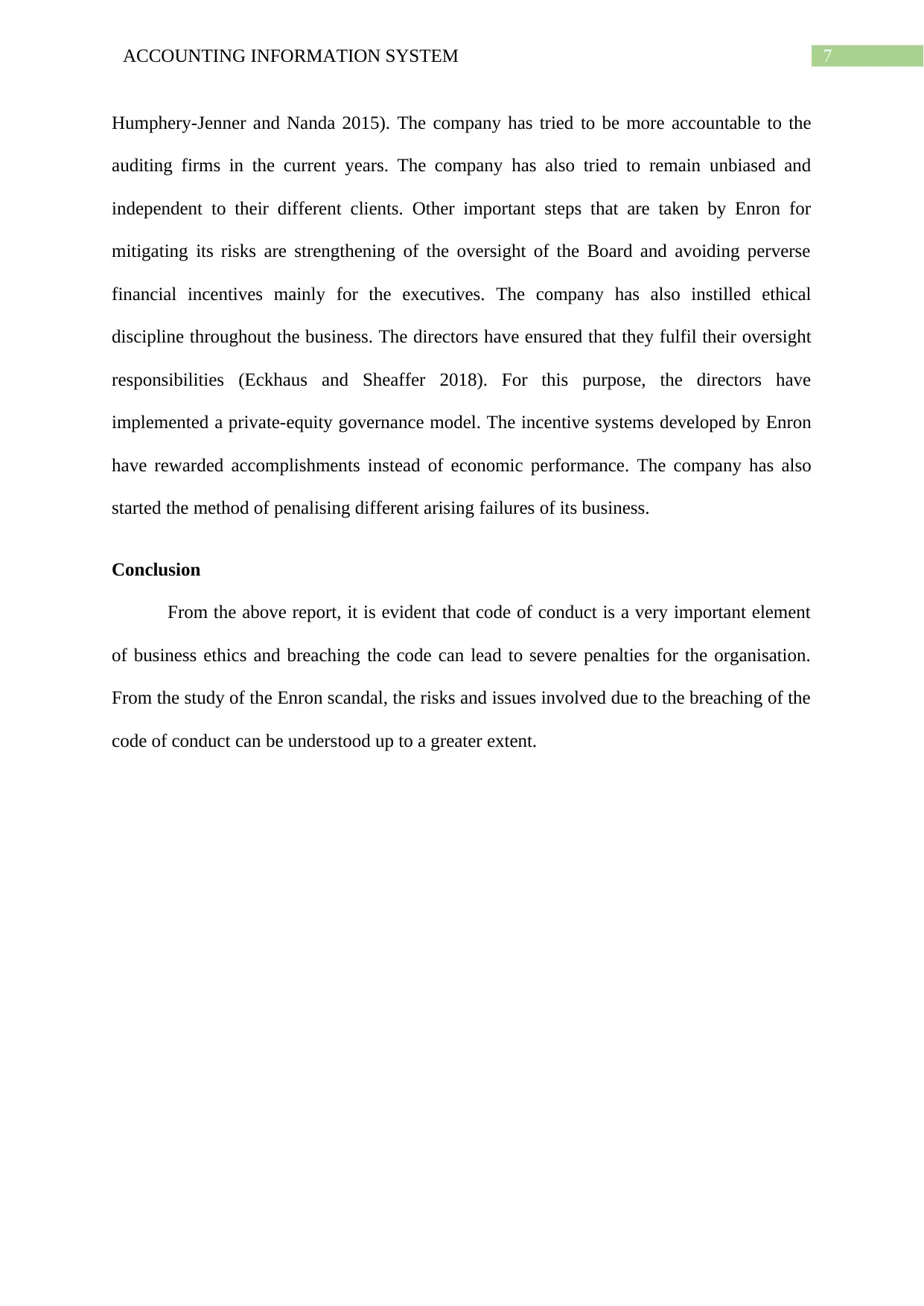
7ACCOUNTING INFORMATION SYSTEM
Humphery-Jenner and Nanda 2015). The company has tried to be more accountable to the
auditing firms in the current years. The company has also tried to remain unbiased and
independent to their different clients. Other important steps that are taken by Enron for
mitigating its risks are strengthening of the oversight of the Board and avoiding perverse
financial incentives mainly for the executives. The company has also instilled ethical
discipline throughout the business. The directors have ensured that they fulfil their oversight
responsibilities (Eckhaus and Sheaffer 2018). For this purpose, the directors have
implemented a private-equity governance model. The incentive systems developed by Enron
have rewarded accomplishments instead of economic performance. The company has also
started the method of penalising different arising failures of its business.
Conclusion
From the above report, it is evident that code of conduct is a very important element
of business ethics and breaching the code can lead to severe penalties for the organisation.
From the study of the Enron scandal, the risks and issues involved due to the breaching of the
code of conduct can be understood up to a greater extent.
Humphery-Jenner and Nanda 2015). The company has tried to be more accountable to the
auditing firms in the current years. The company has also tried to remain unbiased and
independent to their different clients. Other important steps that are taken by Enron for
mitigating its risks are strengthening of the oversight of the Board and avoiding perverse
financial incentives mainly for the executives. The company has also instilled ethical
discipline throughout the business. The directors have ensured that they fulfil their oversight
responsibilities (Eckhaus and Sheaffer 2018). For this purpose, the directors have
implemented a private-equity governance model. The incentive systems developed by Enron
have rewarded accomplishments instead of economic performance. The company has also
started the method of penalising different arising failures of its business.
Conclusion
From the above report, it is evident that code of conduct is a very important element
of business ethics and breaching the code can lead to severe penalties for the organisation.
From the study of the Enron scandal, the risks and issues involved due to the breaching of the
code of conduct can be understood up to a greater extent.
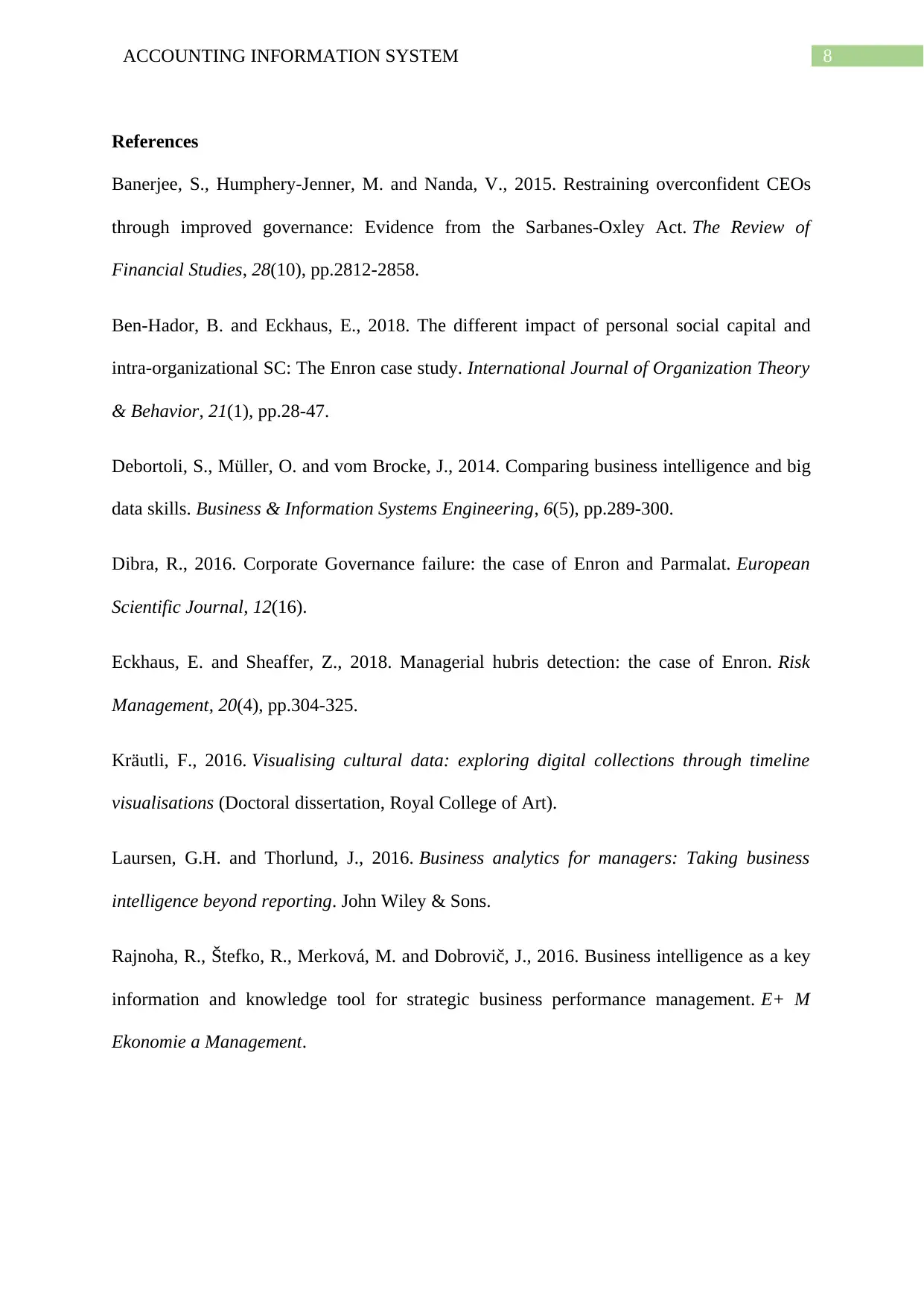
8ACCOUNTING INFORMATION SYSTEM
References
Banerjee, S., Humphery-Jenner, M. and Nanda, V., 2015. Restraining overconfident CEOs
through improved governance: Evidence from the Sarbanes-Oxley Act. The Review of
Financial Studies, 28(10), pp.2812-2858.
Ben-Hador, B. and Eckhaus, E., 2018. The different impact of personal social capital and
intra-organizational SC: The Enron case study. International Journal of Organization Theory
& Behavior, 21(1), pp.28-47.
Debortoli, S., Müller, O. and vom Brocke, J., 2014. Comparing business intelligence and big
data skills. Business & Information Systems Engineering, 6(5), pp.289-300.
Dibra, R., 2016. Corporate Governance failure: the case of Enron and Parmalat. European
Scientific Journal, 12(16).
Eckhaus, E. and Sheaffer, Z., 2018. Managerial hubris detection: the case of Enron. Risk
Management, 20(4), pp.304-325.
Kräutli, F., 2016. Visualising cultural data: exploring digital collections through timeline
visualisations (Doctoral dissertation, Royal College of Art).
Laursen, G.H. and Thorlund, J., 2016. Business analytics for managers: Taking business
intelligence beyond reporting. John Wiley & Sons.
Rajnoha, R., Štefko, R., Merková, M. and Dobrovič, J., 2016. Business intelligence as a key
information and knowledge tool for strategic business performance management. E+ M
Ekonomie a Management.
References
Banerjee, S., Humphery-Jenner, M. and Nanda, V., 2015. Restraining overconfident CEOs
through improved governance: Evidence from the Sarbanes-Oxley Act. The Review of
Financial Studies, 28(10), pp.2812-2858.
Ben-Hador, B. and Eckhaus, E., 2018. The different impact of personal social capital and
intra-organizational SC: The Enron case study. International Journal of Organization Theory
& Behavior, 21(1), pp.28-47.
Debortoli, S., Müller, O. and vom Brocke, J., 2014. Comparing business intelligence and big
data skills. Business & Information Systems Engineering, 6(5), pp.289-300.
Dibra, R., 2016. Corporate Governance failure: the case of Enron and Parmalat. European
Scientific Journal, 12(16).
Eckhaus, E. and Sheaffer, Z., 2018. Managerial hubris detection: the case of Enron. Risk
Management, 20(4), pp.304-325.
Kräutli, F., 2016. Visualising cultural data: exploring digital collections through timeline
visualisations (Doctoral dissertation, Royal College of Art).
Laursen, G.H. and Thorlund, J., 2016. Business analytics for managers: Taking business
intelligence beyond reporting. John Wiley & Sons.
Rajnoha, R., Štefko, R., Merková, M. and Dobrovič, J., 2016. Business intelligence as a key
information and knowledge tool for strategic business performance management. E+ M
Ekonomie a Management.
⊘ This is a preview!⊘
Do you want full access?
Subscribe today to unlock all pages.

Trusted by 1+ million students worldwide
1 out of 9
Related Documents
Your All-in-One AI-Powered Toolkit for Academic Success.
+13062052269
info@desklib.com
Available 24*7 on WhatsApp / Email
![[object Object]](/_next/static/media/star-bottom.7253800d.svg)
Unlock your academic potential
Copyright © 2020–2025 A2Z Services. All Rights Reserved. Developed and managed by ZUCOL.





